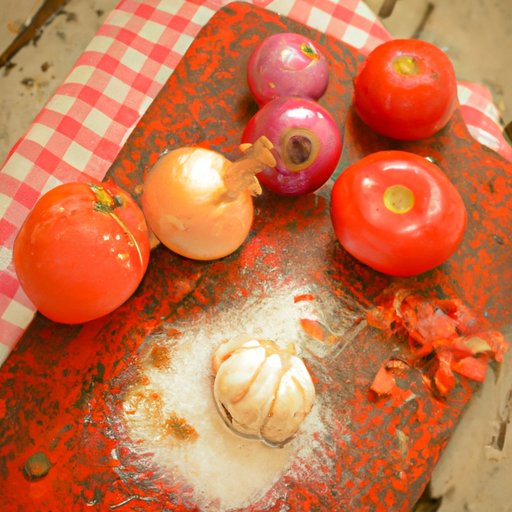Introduction
Cooking healthy meals can be a challenge, but it’s worth the effort. Eating healthily helps maintain your weight, provides essential nutrients, and reduces the risk of chronic diseases. Cooking healthy means selecting nutritious ingredients and preparing them in a way that maximizes their nutritional value.

Creating a Meal Plan for the Week
One of the best ways to ensure you’re eating healthy is to create a meal plan for the week. This will help you save time and money, and reduce your food waste. Plus, it’ll make grocery shopping easier since you know exactly what you need. When creating your meal plan, focus on nutrient-dense foods like fruits, vegetables, whole grains, lean proteins, and healthy fats.
Here are some tips for creating a meal plan:
- Plan out your breakfasts, lunches, dinners, and snacks for the week.
- Choose recipes that use similar ingredients so you can buy in bulk and save money.
- Incorporate leftovers into future meals.
- Keep it simple and don’t overcomplicate things.
- Make sure to include plenty of fruits and vegetables.
Making Smart Ingredient Substitutions
Another way to cook healthier is by making smart ingredient substitutions. For example, instead of using white flour, try using whole wheat flour. Or, rather than using vegetable oil, try using olive oil or coconut oil. You can also substitute full-fat dairy products with reduced-fat versions, and processed meats with leaner cuts of meat.
Here are some strategies for making smart ingredient substitutions:
- Look for recipes that use healthier ingredients.
- Experiment with different types of flours, oils, and dairy products.
- Replace sugary ingredients with natural sweeteners like honey and maple syrup.
- Use herbs and spices to enhance flavor instead of relying on salt.
- Substitute processed meats with fresh leaner cuts of meat.
Using Healthy Cooking Techniques
Healthy cooking techniques are an important part of cooking healthy meals. Common healthy cooking techniques include baking, grilling, roasting, steaming, poaching, sautéing, and stir-frying. These methods are all healthier than deep-frying because they require less fat and retain more of the food’s nutrients.
Here are some tips for using healthy cooking techniques:
- Bake, grill, or roast instead of frying.
- Steam vegetables to retain their vitamins and minerals.
- Poach chicken, fish, and eggs in liquid rather than oil.
- Sauté vegetables in a small amount of olive oil or broth.
- Stir-fry using a non-stick pan and minimal oil.
Learning to Read Nutrition Labels
Reading nutrition labels is another key component of cooking healthy meals. Nutrition labels provide information about the amount of calories, fat, sodium, carbohydrates, protein, and other nutrients per serving. They also list any added sugars and artificial ingredients.
Here are some tips for understanding nutrition labels:
- Look for products with fewer than 5% of the daily recommended values for sodium, sugar, and saturated fat.
- Pay attention to the serving size and number of servings per container.
- Check the ingredient list for added sugars, artificial flavors, and preservatives.
- Compare the nutrition facts of different products to find the healthiest option.
- Choose products with more fiber, vitamins, and minerals.
Choosing Whole Grain Products
Whole grain products are a great source of fiber, vitamins, and minerals. They’re also lower in calories and fat than refined grain products. Examples of whole grain products include oatmeal, brown rice, quinoa, and whole wheat bread. When shopping, look for products labeled “whole grain” and check the ingredient list to make sure the first ingredient is a whole grain.
Here are some benefits of choosing whole grain products:
- Provide essential vitamins, minerals, and fiber.
- Help regulate blood sugar levels.
- Lower cholesterol and reduce the risk of heart disease.
- Promote digestive health.
- Help maintain a healthy weight.

Cooking with Fresh and Seasonal Foods
Cooking with fresh and seasonal foods is another way to ensure you’re eating healthy. Fresh produce contains more nutrients than canned or frozen items, and seasonal produce is often cheaper and tastes better. To find fresh and seasonal produce, visit your local farmers market or join a community-supported agriculture program.
Here are some benefits of cooking with fresh and seasonal foods:
- More nutrients than canned or frozen items.
- Cheaper than out-of-season produce.
- Full of flavor and taste better than store-bought produce.
- Support local farmers.
- Reduce food waste.
Conclusion
Cooking healthy meals is an important part of living a healthy lifestyle. Making smart ingredient substitutions, learning to read nutrition labels, and choosing whole grain products are all important steps in the process. Additionally, creating a meal plan for the week, using healthy cooking techniques, and cooking with fresh and seasonal foods are all great ways to ensure you’re eating nutritious meals.
By following these tips, you’ll be well on your way to cooking healthy meals that are both delicious and nutritious.
(Note: Is this article not meeting your expectations? Do you have knowledge or insights to share? Unlock new opportunities and expand your reach by joining our authors team. Click Registration to join us and share your expertise with our readers.)
